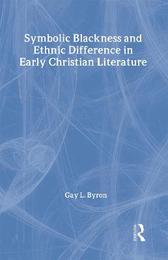
|
Symbolic Blackness and Ethnic Difference in Early Christian Literature
Hardback
Main Details
| Title |
Symbolic Blackness and Ethnic Difference in Early Christian Literature
|
| Authors and Contributors |
By (author) Gay Byron
|
| Physical Properties |
| Format:Hardback | | Pages:240 | | Dimensions(mm): Height 234,Width 156 |
|
| Category/Genre | Christianity |
|---|
| ISBN/Barcode |
9780415243681
|
| Classifications | Dewey:270.08996 |
|---|
| Audience | | Undergraduate | | Postgraduate, Research & Scholarly | | Professional & Vocational | |
|---|
|
Publishing Details |
| Publisher |
Taylor & Francis Ltd
|
| Imprint |
Routledge
|
| Publication Date |
30 May 2002 |
| Publication Country |
United Kingdom
|
Description
This pioneering work provides a well documented examination of some of the main references to Eqyptians/Egypt, Ethiopians/Ethiopia, and Blacks/blackness in early Christian writings. The author explores how perception about ethnic and color differences influenced the discursive strategies of ancient Christian authors. In spite of the basic contention that Christianity was to extend to all peoples, this book demonstrates that certain groups of Christians were marginalised and rendred invisible and silent. They were, in effect, 'blackened by their sins'. The first part of the book explains the theoretical basis for reading ethno-political rhetorics in early Christian writings. The next chapter provides a taxonomy of these rhetorics, classifying the various usages of Egyptians/Egypt, Ethiopians/Ethiopia, and Blacks/blackness within Greco-Roman writings (both Christian and non-Christian). Drawing upon sources from the first to sixth centuries, the author argues that ancient Christians referred to Egyptians, Ethiopians and blacks as a strategy for instructing their followers, maligning their opponenets, and warning their communities about sins and vices, sexual temptations, and 'heresies'. This long-overdue analysis demonstrates the sophisticated ways that Christian writers attempted to shape the self-understandings of their communities through the use of ethnic and color-symbolic language; it also sets out how ethnic and color difference came to symbolise certain theological, ideological, and political intra-Christian controversies and challenges. It will be useful for those studying the New Testament and early Church history, as well as literary theorists and gender critics who will find the book a valuable interdisciplinary resource.
Reviews"Composed of an introduction and two thematic parts, this monograph provides a fresh and distintive appoach to discursive 'othering' in the writing of early Christianity."-Journal of the American Academy of Religion
|